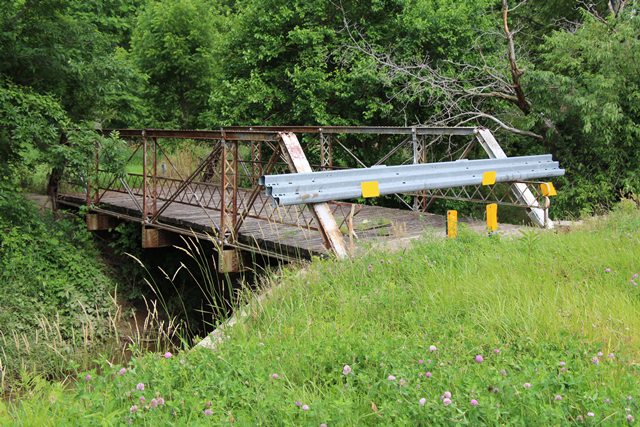We Recommend:
Bach Steel - Experts at historic truss bridge restoration.
BridgeHunter.com Phase 1 is released to the public! - Visit Now
Woodside Road Bridge

Primary Photographer(s): Rick McOmber
Bridge Documented: June 28, 2014
Rural: Crawford County, Ohio: United States
By Builder/Contractor: Canton Bridge Company of Canton, Ohio
Not Available or Not Applicable
50.0 Feet (15.2 Meters)
51.8 Feet (15.8 Meters)
15.7 Feet (4.79 Meters)
1 Main Span(s)
1743910

View Information About HSR Ratings
Bridge Documentation
Although its decorative finial plaques have gone missing, this bridge is an example of a bridge built by the Canton Bridge Company. When the Ohio Historic Bridge Inventory was updated, whoever did it failed to review the old sheet for this bridge, so they failed to recognize the proper builder. The finial plaques were still in place when the old inventory was completed. These details, along with the looped detail at the ends of the railings indicate this is a product of the Canton Bridge Company. The given 1911 construction date in the National Bridge Inventory is assumed to be incorrect, or may indicate the bridge was moved here at that date.
View Archived National Bridge Inventory Report - Has Additional Details and Evaluation
View Historic Bridge Inventory Sheet For This Bridge
Information and Findings From Ohio's Historic Bridge InventorySetting/Context The bridge is closed to traffic. It is on an abandoned 1-lane road in a rural setting. Physical Description The skewed, 1 span, 52'-long, pin-connected Pratt thru truss bridge is traditionally composed of built-up compression members and eyebar or rod tension members. The upper chords are toe-out channels with cover plate and lacing. The verticals are back-to-back angles with lacing. The rolled floorbeams are connected to pin plates below the lower chord pins with bolted field connections. The bridge is finished with lattice railings. Integrity Impact damage to one vertical. Summary of Significance The ca. 1911-14 pin-connected Pratt pony truss bridge is a later example of its type/design with no distinguishing features. The county bridge file has no information on the builder or year built. It is attributed to the Central Construction Company of Columbus, Ohio, based on the floorbeam connections, which are similar to two documented bridges dating from 1911 and 1914 in Columbiana County (1537881 & 1537911). Pratt trusses were undoubtedly the most popular truss design of the last quarter of the 19th century and continued to be built into the 20th century, although eventually superseded in popularity by Warren trusses. The design, which initially was a combination of wood compression and iron tension members, was patented in 1844 by Thomas & Caleb Pratt. Ohio has three covered bridges that use this combination configuration, but they are all modern reconstructions based on the Pratt patent. The great advantage of the Pratt over other designs was the relative ease of calculating the distribution of stresses. More significantly, it translated well into an all-metal design in lengths of less than 200'. Significant surviving examples of all-metal Pratt trusses mostly date to the last quarter of the 19th century, and they are found with thru, pony, and the less common bedstead configuration. Prior to about 1890, a variety of panel point connections were in widespread use (including bolts, cast-iron pieces, and pins), but engineering opinion was coalescing around pins as the most efficient and constructible. Many of the connection details were proprietary and associated with individual builders or companies, and thus earlier examples are generally taken to be technologically significant in showing the evolution of the design. Later post-1890 Pratt trusses show a progression toward less variation in their details such that by 1900 the design was quite formulaic with few significant differences between the designs of various builders. This marked the end of the pin-connected Pratt's technological evolution and, in fact, it was soon waning and eclipsed in the highway bridge market by more rigid, rivet-connected truss designs, particularly the Warren but also riveted Pratts. The transition to riveted connections, which happened even earlier with railroads than highways, was in no small part due to concerns about stress reversals at the pins under heavier loads and improvements in pneumatic field riveting equipment in the early 1900s. In Ohio, Pratt truss highway bridges, whether pinned or riveted, were almost always built under the auspices of counties and local units of government; the Pratt was not a standard design of the state highway department. In Ohio, there are 185 Pratt trusses dating from ca. 1874 to 1945 with at least 60 dating prior to 1900 (Phase 1A, 2008). The technologically significant unaltered examples of pin-connected Pratt trusses for the most part date prior to 1900 and have documented or attributed builders and dates of construction and/or significant connection or member details. Later post-1900 examples are less technologically significant. Significant unaltered examples of riveted-connected Pratt trusses date from ca. 1900 to 1915. Bridge Considered Historic By Survey: No |
![]()
Photo Galleries and Videos: Woodside Road Bridge
Bridge Photo-Documentation
Original / Full Size PhotosA collection of overview and detail photos. This gallery offers photos in the highest available resolution and file size in a touch-friendly popup viewer.
Alternatively, Browse Without Using Viewer
![]()
Bridge Photo-Documentation
Mobile Optimized PhotosA collection of overview and detail photos. This gallery features data-friendly, fast-loading photos in a touch-friendly popup viewer.
Alternatively, Browse Without Using Viewer
![]()
Maps and Links: Woodside Road Bridge
Coordinates (Latitude, Longitude):
Search For Additional Bridge Listings:
Bridgehunter.com: View listed bridges within 0.5 miles (0.8 kilometers) of this bridge.
Bridgehunter.com: View listed bridges within 10 miles (16 kilometers) of this bridge.
Additional Maps:
Google Streetview (If Available)
GeoHack (Additional Links and Coordinates)
Apple Maps (Via DuckDuckGo Search)
Apple Maps (Apple devices only)
Android: Open Location In Your Map or GPS App
Flickr Gallery (Find Nearby Photos)
Wikimedia Commons (Find Nearby Photos)
Directions Via Sygic For Android
Directions Via Sygic For iOS and Android Dolphin Browser
USGS National Map (United States Only)
Historical USGS Topo Maps (United States Only)
Historic Aerials (United States Only)
CalTopo Maps (United States Only)

